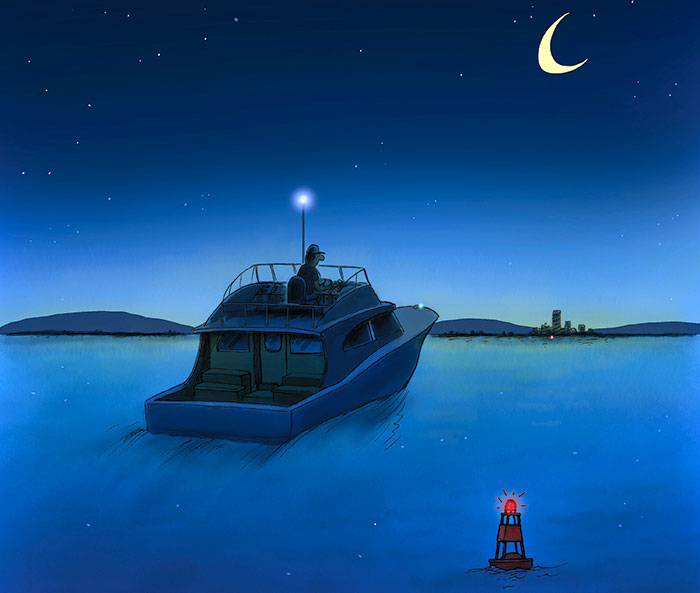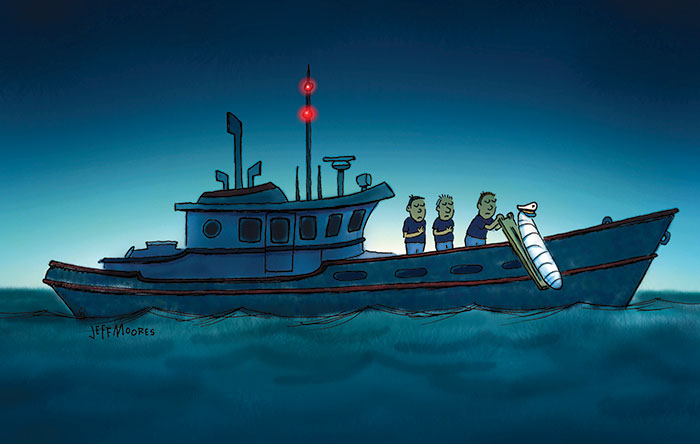Memorizing some of the basic nautical rules is made way easier through these fun rhymes.

Most boaters know at least a couple of rhymes and phrases to help them remember the rules of the road. These memory tools, called mnemonics, are used to help learn or recall information. Many nautical varieties, such as the familiar “red, right, returning,” were created to help sailors navigate safely. Once you know the rules, you can use the rhymes to help you remember them, although there are often exceptions and refinements, and the actual rules rule…not a clever phrase. In that same spirit, here’s a list of popular navigation-themed mnemonics to help keep your time on the water safe and fun.
It’s Left, Right?
Don’t know your right from your left, or more specifically starboard from port? Just remember that the words “left” and “port” have the same number of letters. Another way to look at it would be that right (starboard) has more letters than left (port).
Can’t remember that the red navigation light is located on the port side and green to starboard? That’s an easy one, particularly for wine drinkers. Port is a red-colored wine, so try: “Port wine is red, starboard green is keen,” or, “Is there any red port left in the bottle?”
In And Out
“Red, right, returning” is based on the IALA “B” buoyage system (the one used here in the U.S.). In it, red-colored nun buoys are kept to the right (starboard) side of the boat when returning from the sea and heading into a harbor (although be aware this can differ in some very significant cases).
Imagine, if you will, a day so fine that even Old Red, the retired sailor, got out of his rocking chair and went to sea. That’s where we get the phrase “Even Red left port” (the opposite of “red, right, returning”), which indicates red buoys are left to port when heading out to sea. This particular phrase does triple duty by also reminding you that your red navigation light is on your left (port) side, and that red markers are even-numbered.
“Green, going, gone” is another one to help remember the green buoys are kept to starboard when leaving port.
Know the rules: Remember, mnemonics are intended as a memory aid, not a substitute for knowledge. When it comes to navigation, they are simplifications and summaries and should not be relied on as a sole source of information. It’s important to study the rules (you can find them at navcen.uscg.gov), then use the mnemonics to help you remember them.
It Crossed My Mind
There are plenty of mnemonics for rules of the road and preventing a collision at sea. For help remembering whether you’re the stand-on vessel when boats are crossing, try this little ditty. (But remember there can be exceptions to what may seem like a simple rule. And, the actual rules rule … so study them.)
If to your starboard, red appears,
It’s your duty to keep clear;
To act as judgment says is proper,
To starboard — or port — back — or stop her.
But if upon your port is seen,
A steamer’s starboard light of green,
There’s not so much for you to do,
For green to port keeps clear of you.
Well, technically, there can be plenty for you to do if you see another boat’s green lights on your port side, such as watching the other boat like a hawk to make sure you see the boat holding course and passing you.
Passing “port to port” is common practice during a meeting (a head-to-head situation). However, boats can pass each starboard to starboard as well, as long as both captains agree. To ensure a safe nighttime meeting situation, just remember these:
Green to green or red to red,
Perfect safety — go ahead.
But when both lights you see ahead,
Turn to starboard and show your red.
What To My Wondering Eyes Should Appear
There are plenty of tools to help keep track of navigational lights at night. Two vertical red lights indicate a vessel that’s dead in the water or not under command. Prompt your memory by using the phrase, “Red over red, the captain is dead,” or for the more squeamish, “Red over red, the captain’s in the head.” Have trouble recalling masthead lights for sailboats? Just remember, “Red over green, sailing machine.”
For commercial fishing boats, the phrases, “Red over white, fishing boat lights,” or, “Green over white, trawling tonight,” tell you what they are and the type of fishing they’re engaged in.
Another potentially confusing configuration of lights are those used by tugboats engaged in towing. To help remember what’s what, try these: “White over white, short tug/tow in sight,” a short tow being one under 200 meters (656 feet) in length. “White over white over white, long tug/tow in sight” indicates a tow over 200 meters (656 feet) in length.

Sounds Like, You Know
Finally, intention/agreement signals are used on inland waterways. So here’s a simple way to remember the sound signals you’ll likely hear or use when meeting another vessel in a waterway. Remember, if the vessel you’re approaching sounds two short blasts (a short blast being roughly 1 second in duration), it means they’d like to keep you on their starboard side (a starboard-to-starboard pass). You’d then reply with two blasts of your own horn (assuming you agree). Conversely, a single blast of the horn means a port-to-port passing is desired.

